— by Jan Runyan
We have wonderful neighbors. They watch out for us in many ways. Just a couple of weeks ago, Joanie called to let us know that her daughter, Nicole, who lives nearby, had discovered some big birds building a nest in a tree at the back of her yard. They weren’t sure, but had an idea what kind of birds they were. If we were interested we could go see them any time. So we grabbed binoculars, a scope and our cameras.

Standing in the hot sun on Nicole’s deck, we watched one bird bring in sticks from time to time and give them to the bird who stayed by the developing nest. The “home-body” added the sticks to what looked, to us, like just a loose pile on a tree branch.

Our friends’ search in bird books was accurate…here, high in a tree, on some of the highest land in Brooke County, not near any water or wetlands, were Green Herons making a place to raise a family.
We guessed that it was the female who stayed at the nest while the male flew off and then returned with a stick.

He would land nearby in the tree and walk the branches to the nest. There he gave the stick to the female. She would place the stick in a specific location and then fuss with it while her mate watched.
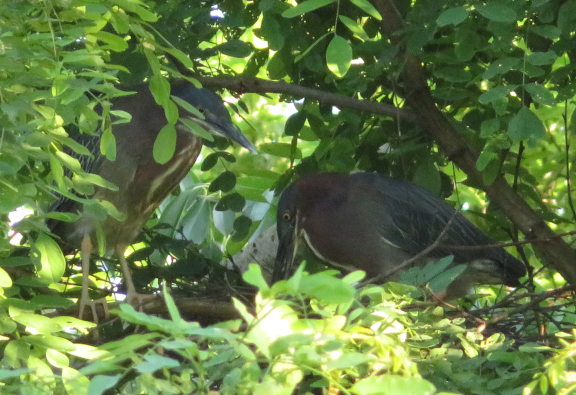
When they both seemed satisfied, he would walk away and then fly off in search of another stick.
While the male was gone, the female rested by the growing nest or fussed with some of the nest sticks, improving the construction.

This continued the whole time we were there.

By the time we left, the nest still looked to us like just a random pile of twigs, but the birds appeared to be satisfied with what they were doing.
Days later, we got a report that a bird was sitting on the nest. Later we were told that Nicole had seen five heads peeking out of the nest. One of the heads seemed to be much younger than the others.
Then, after a windy storm, we got a report that the nest had fallen to a much lower place in some large bushes, but the five babies were still in the disheveled, broken nest.
We went to Nicole’s to see the broken nest with nestlings. From the deck, we looked about eye level at the top of a bush in the back of the yard. A small pile of sticks was all that was left of the nest.
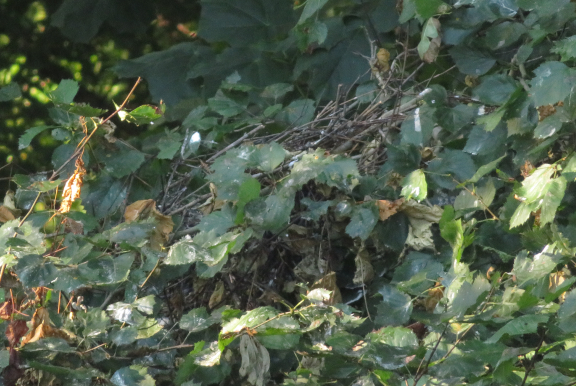
After many minutes of watching with binoculars, we decided that there were no nestlings in it. We searched the bush and the ground around it for signs of movement. Nothing. We were discouraged, but kept looking. Finally, we saw movement high in the branches of the trees, much higher than the broken nest. Looking carefully, we finally identified the movement as the fuzzy butts of Green Heron nestlings.


On their wings, a few adult feathers were starting to show, but they still had a lot of down.

Luckily, Bill discovered that we could get a better view from down below in the yard – wonderfully shaded from the heat of the sun. I set up the tripod for my camera.
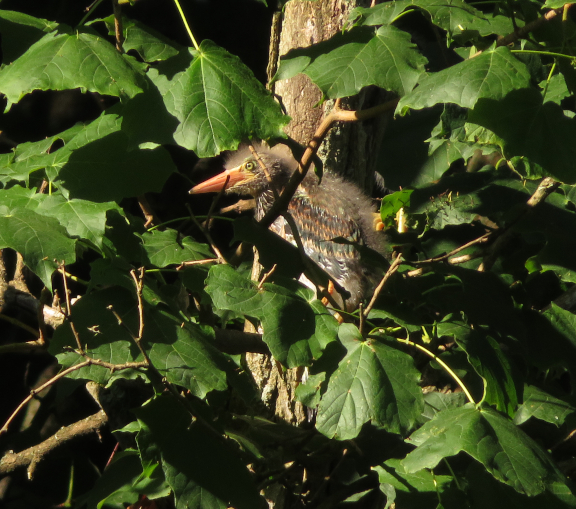
The young herons were well camouflaged, but occasional movement helped us see where they were.
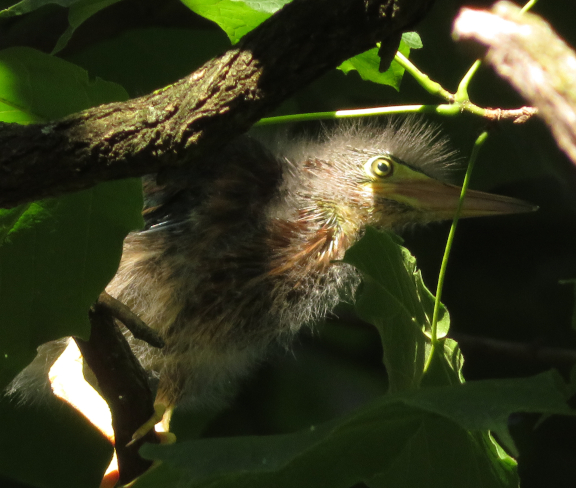

Soon we saw two adult Green Herons fly in, but they stayed on the far side of the tree, nowhere near the two fuzzy butts we were watching. After a few minutes they left without coming anywhere near our two babies. It was puzzling that “our” babies hadn’t been fed. Nicole had said that the adults were feeding the nestlings about every 45 minutes, so we were determined to wait and see them again.
We watched the young birds as they stretched, preened and mostly rested.
From time to time they would move to a slightly different place and I would have to move the camera to keep them in sight.
Usually they were close to each other, but sometimes they moved apart.
It was funny to watch their long yellow toes which support them so well in the muddy water’s edge now wrapped almost all the way around a branch and flexing to help them keep their balance.

It seemed that, on those smaller branches, babies that size would slip and fall hopelessly to the ground where some predator would find them.
Amazingly, they were able to perch on and traverse the branches, although clumsily, without too much difficulty.
Occasionally the pair would touch each other’s bill, almost as if they were trying to get food as they would from an adult.
When they preened, sometimes I could see small pieces of feather sheath falling as a bird bit the sheath to free the newly forming feathers.
45 minutes… From time to time I would get a new angle and more photos or some videos, but no adult Green Herons with food for the young.

1 hour… Bill and I began occasional stretching (birders yoga) similar to the birds we were watching.
1 ½ hours… We met a neighbor who also likes to watch birds.

When another neighbor came by with a loud lawnmower, the birds paid attention for a while, but then one yawned. As he yawned, I learned more about how adult birds can give their babies the food they’re carrying. (Watch carefully at the 17 second mark.)
Finally, when we had been watching for about 2 hours since the adults had last come in, Bill spotted an adult Green Heron fly in – and then another.
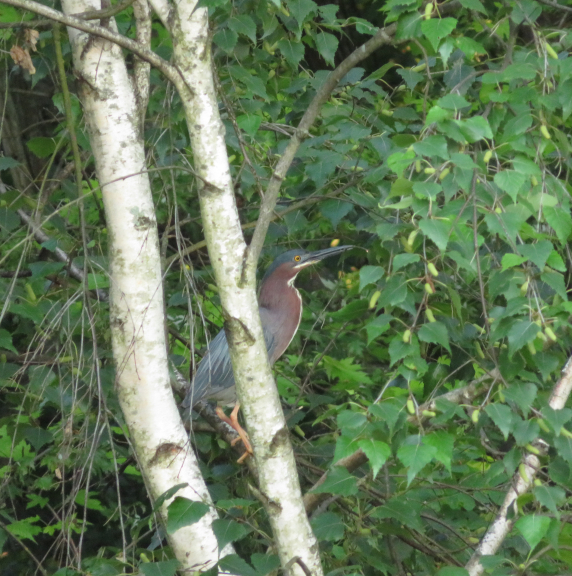
The demeanor of the young ones changed dramatically. They started almost running up and down the branches, flapping their wings and opening their mouths.
We couldn’t hear much, but it was clear that they were actively begging for food.
Twice we saw a rusty-colored adult come to our side of the tree and feed the young we had been watching. The feeding was rapid and somewhat violent. It almost looked as if the adult and young were fighting.
Even after the adults left, the young herons were agitated and begged for a while. Then they calmed down and went back to resting.
After things calmed down, we decided not to wait for the next feeding session – standing for three hours of heron watching was enough in one day for us. It was then that we glimpsed two more Green Heron young way in the back of the tree. One of those was noticeably smaller than the other. We figured that those 2 (or maybe 3 were back there since there had originally been 5 nestlings) had been fed earlier, the first time the adults had come in on the far side of the tree. That was why we had not seen any adults near “our” two birds then.

It was great to verify that at least 4 herons, including the youngest baby, had survived the fall from the original branch and were growing stronger as they exercised, rested and were fed.

We are so grateful to have neighbors who made the effort to share with us the wonders of new bird life!


thanks for sharing, great expericne and pictures ________________________________
LikeLike
Loved reading this one especially since I know the people AND have seen the birds myself !!
LikeLike